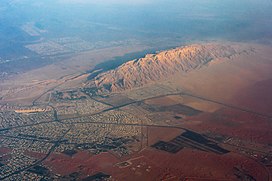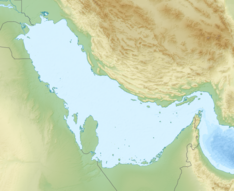| Jebel Hafeet | |
|---|---|
 Aerial view of Jebel Hafeet | |
| Highest point | |
| Elevation | 1,249 m (4,098 ft)(Disputed)[1][2] |
| Prominence | 900 m (3,000 ft)[3] |
| Isolation | 152.72 km (94.90 mi) |
| Coordinates | 24°03′31″N 55°46′39″E / 24.05861°N 55.77750°E |
| Naming | |
| Native name | |
| Geography | |
| Countries | |
| Parent range | Al-Hajar Mountains (sensu lato)[1][6] |
Jabal Hafeet[7] (Arabic: جَبَل حَفِيْت, romanized: Jabal Ḥafīt, "Mount Hafeet"; variously transcribed Jabel or Jebal and Hafit – literally "empty mountain") is a mountain in the region of Tawam, on the border of the United Arab Emirates and Oman, which may be considered an outlier of the Hajar Mountains[1][8] in Eastern Arabia. Due to its proximity to the main Hajar range, the mountain may be considered as being part of the Hajar range. To the north is the UAE city of Al Ain,[9] in the Eastern Region of the Emirate of Abu Dhabi, and the adjacent Omani town of Al-Buraimi.[6]
The sole mountain in the Emirate of Abu Dhabi,[8] and one of the highest mountains in the country,[10] it has given its name to a period in UAE history, the Hafit Period of the Bronze Age (3200 to 2600 BCE), because of the discovery of a cluster of important beehive tombs at its foothills.[11] As of 2017, the mountain is recognised as being part of a national park, and was incorporated into the Sheikh Zayed Network of Protected Areas in 2018.[12][13][14]
- ^ a b c Gardner, Andrew Somerville (January 2004). "The reptiles of Jebel Hafeet". ADCO and Emirates Natural History Group: 149–168. Retrieved 2019-01-14.
{{cite journal}}: Cite journal requires|journal=(help) - ^ Cite error: The named reference
LiethMasoom2012was invoked but never defined (see the help page). - ^ Cite error: The named reference
:0was invoked but never defined (see the help page). - ^ Cite error: The named reference
Edmonds2006was invoked but never defined (see the help page). - ^ Cite error: The named reference
Spalton2006was invoked but never defined (see the help page). - ^ a b The Report Abu Dhabi 2010. Oxford Business Group. 2010. p. 171. ISBN 978-1-9070-6521-7.
- ^ McMorrow, Brian. "Jabal Hafeet". Archived from the original on 2013-12-03. Retrieved 2013-06-04.
- ^ a b Salama, Samir (2011-12-30). "Al Ain bears evidence of a culture's ability to adapt". Gulf News. Retrieved 2018-08-07.
- ^ "Jebel Hafeet Tombs". Abu Dhabi Culture. 2018-02-11. Retrieved 2019-04-01.
- ^ Gillett, Katy (2019-04-18). "Visit the Garden City: New bus route launched between Dubai and Al Ain". The National. Retrieved 2019-04-18.
- ^ Magee, Peter (2014). The archaeology of prehistoric Arabia (1968–). New York. ISBN 978-1-3160-0318-3. OCLC 879421807.
{{cite book}}: CS1 maint: location missing publisher (link) - ^ "Arabian Caracal sighted in Abu Dhabi for first time in 35 years". Emirates 24/7. 2019-02-23. Retrieved 2019-02-23.
- ^ "Arabian Caracal spotted in Abu Dhabi for first time in 35 years". WAM. Abu Dhabi: Khaleej Times. 2019-02-23. Retrieved 2019-02-23.
- ^ "Arabian caracal spotted for first time in Abu Dhabi in 35 years". The National. 2019-02-23. Retrieved 2019-02-23.


